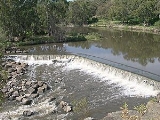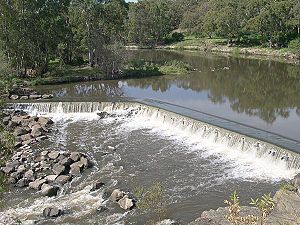
Dights Falls
Encyclopedia


Melbourne
Melbourne is the capital and most populous city in the state of Victoria, and the second most populous city in Australia. The Melbourne City Centre is the hub of the greater metropolitan area and the Census statistical division—of which "Melbourne" is the common name. As of June 2009, the greater...
, Victoria
Victoria (Australia)
Victoria is the second most populous state in Australia. Geographically the smallest mainland state, Victoria is bordered by New South Wales, South Australia, and Tasmania on Boundary Islet to the north, west and south respectively....
just downstream of the junction of the Yarra River
Yarra River
The Yarra River, originally Birrarung, is a river in east-central Victoria, Australia. The lower stretches of the river is where the city of Melbourne was established in 1835 and today Greater Melbourne dominates and influences the landscape of its lower reaches...
with Merri Creek
Merri Creek
The Merri Creek is a waterway in southern parts of Victoria, Australia which flows through the northern suburbs of Melbourne. It begins in Wallan north of Melbourne and flows south for 70km until it joins the Yarra River at Dights Falls...
. At this point the river narrows and is constricted between 800,000 year old volcanic, basaltic
Basalt
Basalt is a common extrusive volcanic rock. It is usually grey to black and fine-grained due to rapid cooling of lava at the surface of a planet. It may be porphyritic containing larger crystals in a fine matrix, or vesicular, or frothy scoria. Unweathered basalt is black or grey...
lava flow and a much older steep, silurian
Silurian
The Silurian is a geologic period and system that extends from the end of the Ordovician Period, about 443.7 ± 1.5 Mya , to the beginning of the Devonian Period, about 416.0 ± 2.8 Mya . As with other geologic periods, the rock beds that define the period's start and end are well identified, but the...
, sedimentary spur. The north side also contains abundant graptolite
Graptolite
Graptolithina is a class in the animal phylum Hemichordata, the members of which are known as Graptolites. Graptolites are fossil colonial animals known chiefly from the Upper Cambrian through the Lower Carboniferous...
fossils in sedimentary sandstone
Sandstone
Sandstone is a sedimentary rock composed mainly of sand-sized minerals or rock grains.Most sandstone is composed of quartz and/or feldspar because these are the most common minerals in the Earth's crust. Like sand, sandstone may be any colour, but the most common colours are tan, brown, yellow,...
.
Magpies occupy the area, and it is said that the Collingwood Football Club
Collingwood Football Club
The Collingwood Football Club, nicknamed The Magpies, is an Australian rules football club which plays in the Australian Football League...
's use of the magpie mascot was inspired by the magpies at Dight's Falls.
Prior to European settlement, the area was occupied by the indigenous
Indigenous Australians
Indigenous Australians are the original inhabitants of the Australian continent and nearby islands. The Aboriginal Indigenous Australians migrated from the Indian continent around 75,000 to 100,000 years ago....
Wurundjeri
Wurundjeri
The Wurundjeri are a people of the Indigenous Australian nation of the Woiwurrung language group, in the Kulin alliance, who occupy the Birrarung Valley, its tributaries and the present location of Melbourne, Australia...
tribe of the Kulin nation
Kulin
The Kulin nation, was an alliance of five Indigenous Australian nations in Central Victoria, Australia, prior to European settlement. Their collective territory extended to around Port Phillip and Western Port, up into the Great Dividing Range and the Loddon and Goulburn River valleys. To their...
. The rock falls would have provided the Aboriginal people with a natural river crossing and place to trap migrating fish. It was also a meeting place for many clans where they would trade, settle disputes and exchange brides.
In January 1803, Charles Grimes
Charles Grimes
Charles Grimes was an English-born surveyor who did some valuable work in colonial Australia. He served as surveyor-general of New South Wales and discovered the Yarra River in what is now the state of Victoria. He is perhaps best known for being the surveyor who mapped the route of the Hobart...
, the deputy surveyor-general of New South Wales, was sent to Port Phillip
Port Phillip
Port Phillip Port Phillip Port Phillip (also commonly referred to as Port Phillip Bay or (locally) just The Bay, is a large bay in southern Victoria, Australia; it is the location of Melbourne. Geographically, the bay covers and the shore stretches roughly . Although it is extremely shallow for...
to survey the area. Sailing on the schooner Cumberland
HMS Cumberland (1803)
HMS Cumberland was a 29 ton schooner built in Port Jackson, Australia, by Henry Moore in 1801. Under the command of Acting Lieutenant Charles Robbin, she was used for Charles Grimes survey of King Island and Port Phillip in early 1803. She was purchased in 1803 to convey Matthew Flinders to England...
, under the command of Acting Lieutenant Charles Robbins, the party entered Port Phillip on 20 January 1803. Grimes explored the Yarra by boat for several miles until he reached Dights Falls on 8 February.
On a ridge above the falls, 250 metres to the east, is an historic marker commemorating the "first white men to discover the river Yarra reaching Yarra Falls on 8th February, 1803. Also to make the first crossing near here with the cattle by the first overlanders John Gardiner
John Gardiner (colonist)
John Gardiner was a nineteenth century Australian banker and pastoralist.-References:*A. S. Kenyon, 'The Overlanders', Victorian Historical Magazine, 10...
, Joseph Hawdon
Joseph Hawdon
Joseph Hawdon was a pioneer settler and overlander of Australia and New Zealand.Hawdon was born at Wackerfield, Durham, England, the son of John Hawdon. At the suggestion of his brother elder brother John , he decided to travel to Australia, arriving in Sydney in November 1834...
and Captain John Hepburn
John Stuart Hepburn
John Stuart Hepburn was an early pastoralist and landholder in Victoria, Australia.Hepburn was born in Scotland in 1800. He initially became a seafaring man and progressed to become a Master of a 226 ton brig, The Alice. In 1835 the Alice sailed for Hobart...
in December 1836".
In the 1840s, an artificial weir was built on the natural bar of basalt boulders to provide water to the "Ceres" flour mill, one of the first in Victoria. Situated by the Yarra River in Collingwood is the industrial relic known locally as "Dight's Mill", one of Melbourne's oldest and most significant industrial sites. In the early 1840's John Dight established Melbourne's first water-powered flour mill on the site. In 1888 'Yarra Falls Roller Mills' built a water-turbine powered mill, which was the largest and most sophisticated of the thirty two water powered mills built in Victoria before 1900.
The area can be readily accessed from the Yarra River Trail.
The rapid has been used many times for the Victorian Canoe Slalom Championships and has been used regularly for training by Australian Olympian Warwick Draper.
The falls are a major obstacle to fish migration up the Yarra River. A fish ladder was installed in 1993, but subsequent research found it "is not functioning adequately and will require modifications to improve its efficiency and effectiveness". Melbourne Water
Melbourne Water
Melbourne Water is a government owned statutory authority that controls much of the water system in Melbourne, Victoria, Australia including the reservoirs, and thesewerage and drainage system that services the city.- Overview :...
have undertaken works from the end of 2010 to replace the weir and construct a new fishway to address this issue.

